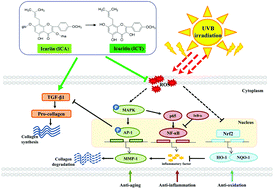当前位置:
X-MOL 学术
›
Photochem. Photobiol. Sci.
›
论文详情
Our official English website, www.x-mol.net, welcomes your
feedback! (Note: you will need to create a separate account there.)
Icariin and icaritin recover UVB-induced photoaging by stimulating Nrf2/ARE and reducing AP-1 and NF-κB signaling pathways: a comparative study on UVB-irradiated human keratinocytes
Photochemical & Photobiological Sciences ( IF 2.7 ) Pub Date : 2018-09-10 00:00:00 , DOI: 10.1039/c8pp00174j Eunson Hwang 1, 2, 3, 4 , Pei Lin 1, 2, 3, 4 , Hien T. T. Ngo 1, 2, 3, 4 , Wei Gao 1, 2, 3, 4 , Yu-Shuai Wang 1, 2, 3, 4 , Hong-Shan Yu 5, 6, 7, 8 , Tae-Hoo Yi 1, 2, 3, 4
Photochemical & Photobiological Sciences ( IF 2.7 ) Pub Date : 2018-09-10 00:00:00 , DOI: 10.1039/c8pp00174j Eunson Hwang 1, 2, 3, 4 , Pei Lin 1, 2, 3, 4 , Hien T. T. Ngo 1, 2, 3, 4 , Wei Gao 1, 2, 3, 4 , Yu-Shuai Wang 1, 2, 3, 4 , Hong-Shan Yu 5, 6, 7, 8 , Tae-Hoo Yi 1, 2, 3, 4
Affiliation

|
Icariin (ICA) and icaritin (ICT) exhibit many pharmacological functions including anti-osteoporosis, anti-cardiovascular, and anti-cancer activities; however, there are few comprehensive studies that track the detailed effects on UVB-induced photoaging. The recovery effects of ICA and ICT were investigated in UVB-irradiated human keratinocytes (HaCaTs). The results indicated that ICT and ICA showed strong radical scavenging activity, and the reactive oxygen species (ROS) scavenging activity of ICT was superior. UVB-induced matrix metalloproteinase-1 (MMP-1) expression was blocked by ICA via the inhibition of mitogen-activated protein kinase/activator protein 1 (MAPK/AP-1), which directly reduced extracellular matrix (ECM) degradation. ICT activated nuclear factor erythroid 2 related factor 2 (Nrf2) to improve the anti-oxidative stress capacity and suppress nuclear factor-κB (NF-κB) activation, decreasing vascular endothelial growth factor (VEGF) protein, and inflammatory cytokines induced ECM degrading enzyme secretion. Moreover, ICT was more advantageous to improve transforming growth factor beta 1 (TGF-β1) and procollagen type I expression than ICA, promoting the synthesis of collagen. Therefore, ICA and ICT have potential to treat UVB-induced oxidative stress, inflammation and photoaging, and will be posited as a novel strategy to alleviate photodamage.
中文翻译:

伊卡瑞汀和伊卡瑞汀通过刺激Nrf2 / ARE并减少AP-1和NF-κB信号通路来恢复UVB诱导的光老化:UVB照射的人角质形成细胞的比较研究
伊卡瑞汀(ICA)和伊卡瑞汀(ICT)具有许多药理功能,包括抗骨质疏松症,抗心血管和抗癌活性。然而,很少有综合研究追踪对UVB诱导的光老化的详细影响。研究了ICA和ICT在UVB辐射的人角质形成细胞(HaCaTs)中的恢复作用。结果表明,ICT和ICA显示出较强的自由基清除活性,而ICT的活性氧(ROS)清除活性更高。UVB诱导的基质金属蛋白酶-1(MMP-1)表达被ICA通过阻断抑制有丝分裂原激活的蛋白激酶/激活蛋白1(MAPK / AP-1),可直接减少细胞外基质(ECM)的降解。ICT激活核因子红系2相关因子2(Nrf2)以提高抗氧化应激能力并抑制核因子-κB(NF-κB)激活,降低血管内皮生长因子(VEGF)蛋白,以及炎性细胞因子诱导的ECM降解酶分泌。此外,与ICA相比,ICT更有利于改善转化生长因子β1(TGF-β1)和I型胶原蛋白的表达,从而促进胶原蛋白的合成。因此,ICA和ICT在治疗UVB引起的氧化应激,炎症和光老化方面具有潜力,将被认为是减轻光损伤的新策略。
更新日期:2018-09-10
中文翻译:

伊卡瑞汀和伊卡瑞汀通过刺激Nrf2 / ARE并减少AP-1和NF-κB信号通路来恢复UVB诱导的光老化:UVB照射的人角质形成细胞的比较研究
伊卡瑞汀(ICA)和伊卡瑞汀(ICT)具有许多药理功能,包括抗骨质疏松症,抗心血管和抗癌活性。然而,很少有综合研究追踪对UVB诱导的光老化的详细影响。研究了ICA和ICT在UVB辐射的人角质形成细胞(HaCaTs)中的恢复作用。结果表明,ICT和ICA显示出较强的自由基清除活性,而ICT的活性氧(ROS)清除活性更高。UVB诱导的基质金属蛋白酶-1(MMP-1)表达被ICA通过阻断抑制有丝分裂原激活的蛋白激酶/激活蛋白1(MAPK / AP-1),可直接减少细胞外基质(ECM)的降解。ICT激活核因子红系2相关因子2(Nrf2)以提高抗氧化应激能力并抑制核因子-κB(NF-κB)激活,降低血管内皮生长因子(VEGF)蛋白,以及炎性细胞因子诱导的ECM降解酶分泌。此外,与ICA相比,ICT更有利于改善转化生长因子β1(TGF-β1)和I型胶原蛋白的表达,从而促进胶原蛋白的合成。因此,ICA和ICT在治疗UVB引起的氧化应激,炎症和光老化方面具有潜力,将被认为是减轻光损伤的新策略。











































 京公网安备 11010802027423号
京公网安备 11010802027423号